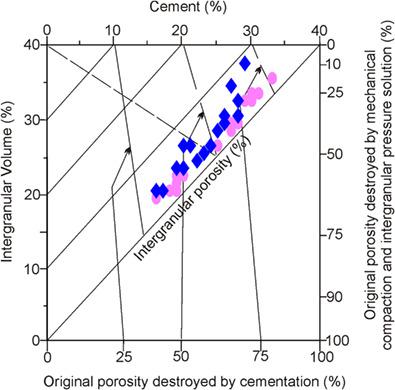当前位置:
X-MOL 学术
›
Geolog. J.
›
论文详情
Our official English website, www.x-mol.net, welcomes your
feedback! (Note: you will need to create a separate account there.)
Role of cementation and compaction in controlling the reservoir quality of the Middle to Late Jurassic Sandstones, Jara dome, Kachchh Basin, western India
Geological Journal ( IF 1.4 ) Pub Date : 2020-09-14 , DOI: 10.1002/gj.3989 Mohammad Adnan Quasim 1 , Shaista Khan 1, 2 , Vineet Kumar Srivastava 3 , Asma Amjad Ghaznavi 1 , Abul Hasnat Masood Ahmad 1
Geological Journal ( IF 1.4 ) Pub Date : 2020-09-14 , DOI: 10.1002/gj.3989 Mohammad Adnan Quasim 1 , Shaista Khan 1, 2 , Vineet Kumar Srivastava 3 , Asma Amjad Ghaznavi 1 , Abul Hasnat Masood Ahmad 1
Affiliation

|
Thin‐section petrography, scanning electron microscopy (SEM) and X‐ray diffraction (XRD) analyses are applied to investigate the various diagenetic controls on the reservoir quality of the Ridge and Athleta Sandstone members (Chari Formation) of the Jara dome, Kachchh Basin, western India. The results show that the sandstones of Jara dome are quartz‐arenite to sub‐arkose, medium‐ to coarse‐grained, sub‐angular to sub‐rounded, poorly to moderately well‐sorted and having low‐ to medium‐sphericity. Diagenetic features such as mechanical compaction, pressure solution, cementation, and dissolution of unstable framework grains are analysed to synthesize the reservoir characteristics. The principal cementing materials are carbonates, iron oxides, silica overgrowth, and authigenic clays, mainly chlorite and kaolinite. Compaction and cementation are the controlling factors for the reduction in porosity and permeability of the sandstones. Dissolution of detrital feldspars is the main cause of porosity enhancement in these sandstones. The relationship between the intergranular volume (IGV) and cement volume indicates that cementation had played a more important role in the destruction of primary porosity than that of compaction. On the one hand, the ubiquitous development of carbonate cement advocates the loss in primary porosity at the early stage of diagenesis, while on the other hand it also prevented the further compaction of sandstone, thus preserving unfilled voids as primary porosity. Precipitation of carbonate cement is followed by development of pore‐lining and pore‐filling clayey cements. The pore‐filling kaolinite resulted in a considerable loss of porosity while the pore‐lining chlorite has helped in retaining the porosity by preventing syntaxial silica overgrowths. The reservoir quality of the studied sandstone is reduced by the authigenic clay cements, early carbonate precipitation and silica overgrowths, nonetheless, it is improved by the dissolution and alteration of unstable grains, in addition to partial dissolution of carbonate cements. The potential of the studied sandstone to act as a reservoir is strongly related to sandstone diagenesis.
中文翻译:

胶结和压实在控制中西部侏罗纪砂岩储层质量中的作用,印度西部卡奇盆地贾拉穹顶
薄层岩石学,扫描电子显微镜(SEM)和X射线衍射(XRD)分析被用于研究对喀什赫尔盆地贾拉穹顶山脊和Athleta砂岩段(Chari组)储层质量的各种成岩控制作用,印度西部。结果表明,贾拉穹顶的砂岩为石英亚砷酸盐至亚弓形,中度至粗粒度,亚角至亚圆度,不良至中度分类良好,低至中度球形。分析了成岩特征,如机械压实,压力固溶,胶结作用和不稳定骨架颗粒的溶解,以合成储层特征。主要的胶结材料是碳酸盐,氧化铁,二氧化硅过度生长和自生粘土,主要是绿泥石和高岭石。压实和胶结是降低砂岩孔隙率和渗透率的控制因素。碎屑长石的溶解是这些砂岩中孔隙度增加的主要原因。粒间体积(IGV)和水泥体积之间的关系表明,胶结作用在破坏原始孔隙方面比压实作用更为重要。一方面,碳酸盐水泥的无处不在发展提倡在成岩作用的早期阶段降低主要孔隙度,另一方面,它也阻止了砂岩的进一步压实,因此保留了未填充的孔隙作为主要孔隙度。碳酸盐水泥的沉淀之后是开有孔隙的衬砌和填充孔隙的黏性水泥。填充孔的高岭石导致了相当大的孔隙率损失,而填充孔的亚氯酸盐通过防止语法上过度的二氧化硅生长帮助保持了孔隙率。自生粘土水泥,早期碳酸盐沉淀和二氧化硅过度生长降低了所研究砂岩的储层质量,但是,除了碳酸盐水泥的部分溶解外,不稳定颗粒的溶解和改变也改善了砂岩的储层质量。被研究的砂岩作为储层的潜力与砂岩的成岩作用密切相关。除了部分溶解碳酸盐水泥外,还可以通过不稳定颗粒的溶解和改变来改善它。被研究的砂岩作为储层的潜力与砂岩的成岩作用密切相关。除了部分溶解碳酸盐水泥外,还可以通过不稳定颗粒的溶解和改变来改善它。被研究的砂岩作为储层的潜力与砂岩的成岩作用密切相关。
更新日期:2020-09-14
中文翻译:

胶结和压实在控制中西部侏罗纪砂岩储层质量中的作用,印度西部卡奇盆地贾拉穹顶
薄层岩石学,扫描电子显微镜(SEM)和X射线衍射(XRD)分析被用于研究对喀什赫尔盆地贾拉穹顶山脊和Athleta砂岩段(Chari组)储层质量的各种成岩控制作用,印度西部。结果表明,贾拉穹顶的砂岩为石英亚砷酸盐至亚弓形,中度至粗粒度,亚角至亚圆度,不良至中度分类良好,低至中度球形。分析了成岩特征,如机械压实,压力固溶,胶结作用和不稳定骨架颗粒的溶解,以合成储层特征。主要的胶结材料是碳酸盐,氧化铁,二氧化硅过度生长和自生粘土,主要是绿泥石和高岭石。压实和胶结是降低砂岩孔隙率和渗透率的控制因素。碎屑长石的溶解是这些砂岩中孔隙度增加的主要原因。粒间体积(IGV)和水泥体积之间的关系表明,胶结作用在破坏原始孔隙方面比压实作用更为重要。一方面,碳酸盐水泥的无处不在发展提倡在成岩作用的早期阶段降低主要孔隙度,另一方面,它也阻止了砂岩的进一步压实,因此保留了未填充的孔隙作为主要孔隙度。碳酸盐水泥的沉淀之后是开有孔隙的衬砌和填充孔隙的黏性水泥。填充孔的高岭石导致了相当大的孔隙率损失,而填充孔的亚氯酸盐通过防止语法上过度的二氧化硅生长帮助保持了孔隙率。自生粘土水泥,早期碳酸盐沉淀和二氧化硅过度生长降低了所研究砂岩的储层质量,但是,除了碳酸盐水泥的部分溶解外,不稳定颗粒的溶解和改变也改善了砂岩的储层质量。被研究的砂岩作为储层的潜力与砂岩的成岩作用密切相关。除了部分溶解碳酸盐水泥外,还可以通过不稳定颗粒的溶解和改变来改善它。被研究的砂岩作为储层的潜力与砂岩的成岩作用密切相关。除了部分溶解碳酸盐水泥外,还可以通过不稳定颗粒的溶解和改变来改善它。被研究的砂岩作为储层的潜力与砂岩的成岩作用密切相关。











































 京公网安备 11010802027423号
京公网安备 11010802027423号